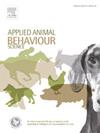Prediction of successful training outcomes for drug detection dogs using subjective ratings and behavioral test measures: A case study in Japan customs
IF 2.2
2区 农林科学
Q1 AGRICULTURE, DAIRY & ANIMAL SCIENCE
引用次数: 0
Abstract
Drug detection dogs, primarily employed by customs and police forces, play a crucial role in preventing the spread of illegal drugs worldwide. To minimize training costs, accurately predicting which dogs will succeed in scent detection training is essential. Local training organizations seek validated behavioral assessment methods for this purpose, but the wide range of methods used and the lack of scientific verification pose challenges. Previous research on detection dogs in Japan focused on genetics, but behavioral assessment methods for training have been understudied. To bridge the gap, the current study aimed to outline and evaluate the predictive validity of behavioral assessment systems used for drug detection dogs at Japan Customs. We compared the relative effectiveness of two different behavioral assessment methods: subjective ratings by chief trainers and behavioral measures in a novel test situation. For subjective ratings, we used subscales of Training Focus (i.e., interest in play, independence, concentration, activity, and boldness) and Tolerance (i.e., friendliness to humans and tolerance to dogs) to characterize a dog’s personality. For behavioral tests, a simple behavioral test measured a dog’s approach behavior and reactivity to an unfamiliar person. Data from 196 dogs (159 Labrador Retrievers and 37 German Shepherds) showed high inter-rater agreement for both methods. A GLMM model revealed that Training Focus subscale scores significantly predicted training success of candidate dogs. On the other hand, Tolerance scores and behavioral test measures were poor predictors for scent detection work. Dog breed and sex did not significantly influence final training outcomes. Receiver Operating Characteristic (ROC) curves indicated that Training Focus scales' classification performance for training success is comparable to or better than previous reports for assistance and detection dogs. These findings demonstrate the predictive validity of subjective Training Focus ratings, aiding in the selection of drug detection dogs at Japan Customs. While generalizability to other detection dog populations and identification of alternative behavioral predictors remains uncertain, this study provides valuable insights into the predictive accuracy of trainer ratings in a dog behavior assessment system.
求助全文
约1分钟内获得全文
求助全文
来源期刊

Applied Animal Behaviour Science
农林科学-行为科学
CiteScore
4.40
自引率
21.70%
发文量
191
审稿时长
18.1 weeks
期刊介绍:
This journal publishes relevant information on the behaviour of domesticated and utilized animals.
Topics covered include:
-Behaviour of farm, zoo and laboratory animals in relation to animal management and welfare
-Behaviour of companion animals in relation to behavioural problems, for example, in relation to the training of dogs for different purposes, in relation to behavioural problems
-Studies of the behaviour of wild animals when these studies are relevant from an applied perspective, for example in relation to wildlife management, pest management or nature conservation
-Methodological studies within relevant fields
The principal subjects are farm, companion and laboratory animals, including, of course, poultry. The journal also deals with the following animal subjects:
-Those involved in any farming system, e.g. deer, rabbits and fur-bearing animals
-Those in ANY form of confinement, e.g. zoos, safari parks and other forms of display
-Feral animals, and any animal species which impinge on farming operations, e.g. as causes of loss or damage
-Species used for hunting, recreation etc. may also be considered as acceptable subjects in some instances
-Laboratory animals, if the material relates to their behavioural requirements
 求助内容:
求助内容: 应助结果提醒方式:
应助结果提醒方式:


